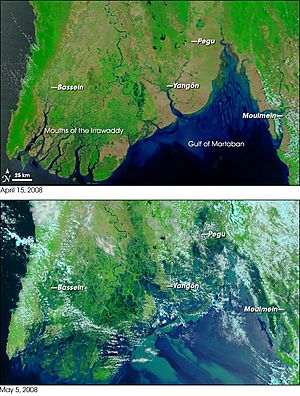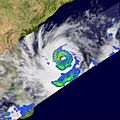Cyclone Nargis facts for kids
Cyclone Nargis was a very powerful tropical cyclone. It was the first big storm in the Indian Ocean in 2008. This storm was a Category 4, which means it was extremely strong. It hit the country of Myanmar (also known as Burma) in April and May 2008. Many people believe it was one of the worst storms Myanmar has ever experienced.
The United Nations (UN) reported that about 1.5 million people were badly affected by Cyclone Nargis. Sadly, at least 78,000 people were killed, and 58,000 were missing. In one town alone, 80,000 deaths were reported. After the disaster, the government of Myanmar asked for international help. Some people felt the government struggled to handle the situation.
Later, the government said around 80,000 people had died. Other groups helping out thought the final number would be over 100,000. Aid workers who came to Myanmar estimated that 2 to 3 million people lost their homes. They said it was the worst disaster in Myanmar's history. It was compared to the 2004 Indian Ocean tsunami. An expert from a British charity said it was "unprecedented" for Burma. He thought there might be more deaths than the tsunami caused in Sri Lanka. The UN stated that up to 2.5 million people urgently needed help. Many affected areas were cut off, making it hard to reach people. The Red Cross thought up to 128,000 people could have died.
The storm caused the government to declare five regions as disaster areas. These were Yangon, Ayeyarwady, Bago Divisions, and Mon and Kayin States. Thousands of buildings were destroyed. In the town of Labutta, 75% of buildings collapsed, and 20% lost their roofs. Cyclone Nargis is thought to be the deadliest tropical cyclone since Hurricane Mitch in 1998. Hurricane Mitch killed about 18,000 people. At least 10,000 people died in the delta town of Bogale.
A diplomat in Yangon described the area as a "war zone." Flooding from damaged pipes ruined rice crops. A UN official said, "It's a bad situation. Almost all the houses are smashed. People are in a terrible situation." Another UN representative noted that the Irrawaddy Delta was hit hard. This was due to strong winds, heavy rain, and a huge storm surge. A UK newspaper, The Daily Telegraph, reported that food prices in Myanmar might go up because of the disaster.
Helping After the Storm
On May 6, 2008, Myanmar's government officially asked the United Nations for help. However, they were careful about accepting too much outside assistance. By May 7, 2008, the government said they would accept international help. They preferred direct help from one government to another. A big problem was getting visas for aid workers to enter the country.
On May 8, 2008, the government allowed Italian flights with UN relief supplies to land. These flights carried 25 tonnes of goods. Many countries and organizations wanted to send help quickly. Their officials, supplies, and equipment waited in Thailand and at Yangon airport. This was because the Myanmar government was slow to give visas to many aid workers. This situation caused worry that some food and medicine might spoil before it could be delivered.
Cyclone Nargis caused a lot of damage in Myanmar. It happened on May 2, 2008. The storm was a Category 4, with winds of about 105 miles per hour. It caused destruction and at least 138,000 deaths. Around 55,000 people were missing. In Sri Lanka, the cyclone brought heavy rainfall. This led to flooding and landslides in ten districts. The districts of Ratnapura and Kegalle were most affected. More than 3,000 families were impacted there. Thousands of houses were flooded, and 21 were destroyed. The rain left 4,500 people homeless. More than 35,000 people on the island were affected. Three people were injured, and two died in Sri Lanka. The cyclone also lowered temperatures along the Indian coastline.
Many countries sent aid:
- Thailand sent US $100,000 in supplies. They also sent 30 tonnes of medical supplies and 12 tonnes of food.
- Italy provided 30 tons of emergency equipment. This included stretchers, generators, and water purifiers.
- The United Kingdom gave ₤17 million.
- Australia gave $25 million and 31 tonnes of supplies.
- Belgium sent €250,000.
- China sent $10 million in relief resources.
- France gave 1,500 tons of medicine, food, and water.
- Germany sent $3.0 million. All these efforts aimed to help the people affected by the storm.
Challenges for Aid Efforts
Helping people in Myanmar after the cyclone was very difficult. Emergency teams wanted to help. However, the government made it hard for international aid to reach those in need. They also made it difficult for their own citizens to get help. Aid workers were sometimes arrested. The government also limited access to areas that needed rebuilding. This meant people did not always get the resources they needed to recover from Cyclone Nargis.
Images for kids
-
US Air Force personnel deliver relief supplies to Myanmar
-
A destroyed house in Yangon
See also
 In Spanish: Ciclón Nargis para niños
In Spanish: Ciclón Nargis para niños









